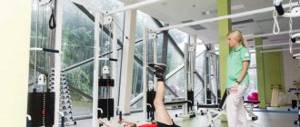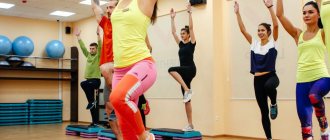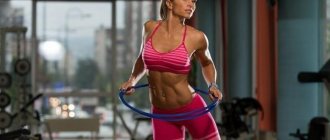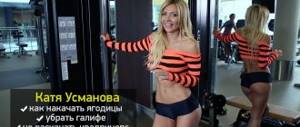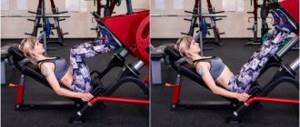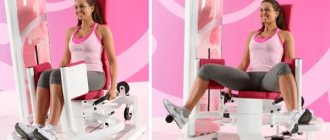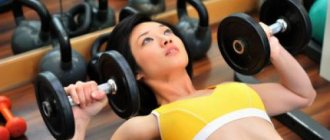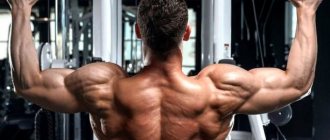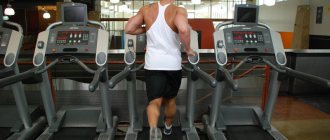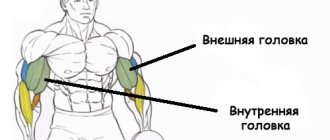Hello, dear friends! Today the topic under consideration is “Which muscles work on which simulators?”
The topic is pressing. Before going directly to the hall, we need to understand what we will see there and what to do with this magnificence. Beginners, and often regulars, sometimes don’t know how to diversify their classes with new exercises. And not everyone has time to share their knowledge about the functionality of simulators.
I suggest you take a kind of “Young Fighter Course.” Are you ready? Go! To begin, outline for yourself a rough training plan that you will always follow. Include a warm-up, main part, and cool-down. Warm-up and cool-down should take at least 20 minutes. Such rules were invented in order to adjust the body to a different environment. Time management rules are important to follow to obtain results and prevent injuries.
Types of simulators
Let's consider all types of simulators on which we will train.
What types of simulators are there:
- Cardio machines.
- Strength training equipment.
- Block simulators.
If the question arises - “What kind of exercise machine will help you get rid of your belly and sides?”, then any correctly chosen trainer will confidently point you to the cardio room, because that’s where the most effective exercise machines for reducing volume are located.
Almost everything in the cardio zone additionally pumps the buttocks and legs. If you are more interested in what kind of exercise machine you can use to pump up your buttocks, then you should go to the “rocking room” - the weight room. Block simulators are a special article.
Formally, they belong to the power category, but they are singled out because of their versatility. They contain “Bottom Blocks” (those that are attached to the bottom, and which most often need to be pulled up) and “Top Blocks” (those that are attached to the top, and they need to be pulled down). Sasha Bogrtich trained on them when she starred in the film “I’m Losing Weight.”
Rowing machine for home
Involves the muscles of the arms and abs. It has a fairly low cost and is compact.
The load is distributed evenly. Despite all of the above, they are not so popular. This is probably because they take time to master.
It is not advisable to use a rowing machine for those who have problems with the spine.
So, cardio equipment, which one should you choose?
Exercise bike
Treadmill
Ellipsoid
Stepper
- The bike trainer develops overall endurance, strengthens your calves and legs in general.
- The ellipse is similar to a bicycle, but is more aimed at the quadriceps (by adjusting the length of the step, you can change the emphasis of the load from the front of the thigh to the buttocks).
- The treadmill strengthens your legs and increases endurance (This is the most energy-intensive type of exercise machine, but you should use it with CAUTION: the impact load can have a bad effect on your knees, it is recommended to alternate with the ellipse).
- The stepper simulates walking up the stairs, pumping up the buttocks and quadriceps.
All cardio equipment improves endurance and helps burn calories; you can choose the one you like best for your workout. Interval loads are more effective in fat-burning training - cyclic alternation of load or speed (depending on the simulator).
The next point is which simulator trains which muscles. The list of exercise equipment and exercises by muscle group will be listed in small sections for ease of perception.
What exercise machines pump up the shoulder girdle and arms?
Dumbbell Raise
Lower block thrust in a crossover
Upper block thrust in a crossover
One-handed lower pulley in a crossover
For the shoulders, free weights such as dumbbells and barbells are mostly suitable.
- To work the deltoid muscles (they are located directly above the shoulder joint), exercises are used to lift dumbbells to the sides, forward, and up. These muscles are small and get tired quickly, so about 20 repetitions will be enough for you to feel the exact location of your deltoids.
- Biceps are pumped by all exercise machines associated with bending the arm. For example, lower block rows for biceps in a block machine.
- The triceps are pumped opposite, with arm extensions. The same block simulator, but we take the top block and pull it down.
- Pull the crossover lower block with one hand
What exercise machines pump up your chest?
Dumbbell curls lying on a bench
Reduction of arms in the “Butterfly” simulator
Thrust of the upper block with straight arms in a crossover
Bringing hands together in crossover
The pectoral muscles can be trained using push-ups, barbells, or machines such as:
- “Butterfly” (the most democratic exercise machine, suitable for both girls and men).
- Bringing your arms together in a crossover (guys will like it more; it looks like two cables that need to be brought together with force in front of your chest).
- Pull the upper block down with straight arms (we try to feel that it is the chest that is working, not the arms).
- All kinds of benches are assistants for working with dumbbells.
Choosing a strength trainer[edit | edit code]
We think you understand that installing the entire line of power machines in your home is impractical. Of course, maybe you don’t mind paying a tidy sum for the mechanisms themselves and adding a special outbuilding for them, but this is simply not necessary. A much smarter alternative would be to buy a multi-purpose trainer, which combines several useful devices in one frame. Most of these machines have one or two stacks of weights, so one or two athletes can train on them at the same time. Good multi-purpose machines provide your muscles with a good workout, although they may not look as neat or solid as the machines at the gym.
It is better to choose a multi-purpose exercise machine in specialized sports equipment stores, rather than in department stores, and definitely do not order by phone from a TV advertisement. First, visit several sports stores to compare prices. If you don't know of a store near your home, call the exercise equipment manufacturers and ask for the address of the nearest dealer. In some cases, it is cheaper to buy a trainer directly from the manufacturer. Some good brands that make multi-purpose exercise equipment include Parabody, Paramount, Universal, Vectra, Pacific, Hoist, and California Gym. Below you will find some tips for purchasing multi-purpose exercise equipment.
Rules for choosing a simulator:
- Look for firm, thick seat cushions filled with dense foam rubber. Seats covered with more resistant material are easier to clean. After all, the pillow is the part of the device that comes into most contact with your body, including your sweaty body. With a cleanable cover, you can wash your sweat off the machine after each workout.
- Look for machines that use plastic-coated cables rather than chains or giant rubber bands. Check the equipment for any malfunctions, damage or wear.
- Check that you can perform all the exercises for which the power station is designed. Some may be comfortable for you, while others may feel like your limbs are being twisted out of their sockets. Look for machines in which the load moves smoothly and without delays. In some mechanisms, heavy loads move normally, but one or two plates may dangle, rattle, or get stuck during movement.
- Make sure that the parts of the machine are easily adjustable. You don't want to spend half your workout adjusting the seat and levers to your body—especially if someone else will be using the machine.
- Look for equipment whose seller provides free assembly. Forget about “plain and simple” instructions. They won't help you. Trying to assemble some of the simulators yourself is like trying to build a spaceship from the instructions.
What exercise machines work your back?
Smith machine row
Smith machine squats
Pull the lower block vertically
Raising the torso on a hyperextension bench
The back is our everything. Let's see what the weight room has in the arsenal for her.
- From experience, the most effective exercise machine for the back is a hyperextension bench (the deep layers of muscles, skeletal, are trained).
- “Smith machine” In it you can perform rows of a barbell to the waist (mainly the latissimus dorsi muscles work).
- Seated vertical block row (the name is complicated, but the exercise is easier).
- Squats with a barbell in a Smith machine (most importantly, a basic exercise for the legs and buttocks).
Classification of simulators
When choosing methods of training on strength training equipment, you should be aware of the existence of the following categories of equipment:
- Models working under their own weight;
- Block devices with built-in weight;
- Loadable free weight equipment.
Strength training equipment is divided according to its purpose. Some of them are intended only for professional use and are suitable for a gym or sports complex. There are models that can be placed both in a large room and in an apartment. The most compact versions are intended for home use only.
Under its own weight
The principle of loading in this category of equipment is the use of your own body weight.
- Bars are a great option for training your abdominal muscles, back, arms and chest.
- The horizontal bar is suitable for strengthening the press.
- The bench allows you to pump up the oblique abdominal and deltoid muscles.
- Hyperextension is chosen to train the back, legs and buttocks.
The advantages include versatility due to the combination of several functions at once and the use of almost every muscle group during training. The load is increased or decreased by changing the inclination of the body of the exercising person or the bench used for exercise. For the same purpose, additional weights are sometimes attached to the body.
Features of using such simulators:
- With their help, endurance increases and the figure is tightened, the relief is formed and the muscles are toned;
- The devices help to get rid of excess weight, positively affecting the metabolism in the body;
- The absence of complex mechanisms allows you to use this simulator longer than other types;
- Without hanging a load on such a machine, you will not be able to gain muscle mass.
The exercise machines are suitable for both beginners and professionals; they can be installed at home, in a gym or sports complex.
With built-in weight
If the design of the simulator already has a flat load of a certain mass, it is called equipment with built-in weight.
The operating principle of such a device:
- The load is held with a clamp;
- When moving during exercise, weights move along rods or along guide cables, maintaining a constant load on the muscles;
- The weight can be changed by moving the lock.
The simulators are suitable for training individual muscles - back, arms, abs. Automation of the load allows them to be used even by beginners and without supervision from a trainer. Universal models designed to train different parts of the body are called multi-stations.
With free weight
Equipment of this type consists of a main part (frame, bench or other structure) and various equipment - dumbbells, weights, weights. Exercise machines allow you to gain weight and volume faster compared to other types. Therefore, they are intended, first of all, for professional athletes or amateurs who have been training for quite a long time.
One type of such simulators is called “thrust row with emphasis” and is designed to develop biceps, teres and latissimus dorsi muscles. An athletic bench is considered a universal device. It is suitable for strengthening different types of muscles and can be used in two positions - lying or sitting. The Scott bench is used for isolated biceps training.
Purpose
According to their intended purpose, simulators can be home, semi-professional (fitness class) and professional.
Models of the first type are usually foldable, their weight does not exceed 50 kg, and the load is 100 kg. To increase weight, simple mechanical devices or blocks are used. The design may include expanders, and the main features are versatility and compactness.
The second type is fitness class equipment. Here, too, versatility is of primary importance, but the sizes are larger than those of home models. The manufacturing quality of semi-professional simulators is higher, the weight of the athlete can be maintained - more than 120 kg, the load reaches 150 kg or more.
Professional models are durable, quiet and smooth in operation. Maximum load is more than 150 kg. They are rarely purchased for personal use due to their high price and large size. Despite the fact that most devices allow you to perform only 1-2 exercises.
What exercises pump up the abs?
Raising your torso on a bench
Crossover crunches
Leg pull-ups in the simulator Hanging leg raises
The “plank” exercise is ideal for general strengthening of the core. Rarely a trainer has not been tortured with the question - “What is the most effective abdominal exercise machine?” There are several simulators, all of them are associated with bending the torso forward (if conventionally, then head to hips)
- Twisting on a block (pull the upper block down, as if slouching).
- Raising the torso on a bench (like at school).
- Hanging leg raises (machine with support under the elbows).
- Pulling up legs with weights (pendulum-type exercise machine).
Treadmill
Ideal to keep your figure in excellent condition. It can be used for both running and walking – that is, to perform natural movements for humans. It allows you to spend quite a lot of energy without a particularly heavy load, strengthens the lungs, heart and blood vessels, and increases muscle tone.
The treadmill does not require any preliminary preparation.
Minuses:
- Expensive.
- High noise level during operation.
- Quite large in size and weight.
- Not recommended for people with problem joints and spine.
What exercise machines work your legs?
Calf raises with weights Leg curls in a machine Leg extensions in a machine Leg press in a machine
The legs include several muscle groups: quadriceps (front of the thigh); biceps (back of the thigh); calves (everything is clear with them) and buttocks (we will look at them separately, because the most interesting thing for all girls is to know which exercise machines to use to pump up their buttocks)
- The leg press machine trains the legs comprehensively (depending on the placement of the legs, a little emphasis can be placed)
- Leg extension in the simulator (pumps the quadriceps in isolation. We sit on a chair and simply straighten our legs)
- Leg bending in a machine (works the biceps in isolation, looks like a bench with a roller. We place the roller below the calves and bend the legs)
- We pump our calves by lifting them onto their toes with weights. (you can use a barbell on a Smith machine)
Exercise machines for gluteal muscles
Reduction, spread of legs
Smith machine lunges
Leg abduction in crossover
Romanian deadlift on the Smith machine
So, finally, let's look at what exercise machines pump up the buttocks. Let me remind you that the gluteal muscles are divided into large, small and medium. One lies under the other. In order to get good shape, you need to pay attention to each of them.
- Lower block row (we secure the cable of the block with a cuff on the leg, and perform back swings).
- Romanian deadlift in the Smith machine (a must for those who really want to pump up beautiful buttocks).
- Lunges with a barbell in a Smith machine (we try to squat on one leg, leaning slightly on the other).
- Lowering and spreading the legs in the simulator (we train the gluteus minimus muscles, add volume to the butt).
- Squats in a Smith machine (simpler than regular squats due to the reduced effort required to maintain balance).
In every exercise that you perform for the first time, it is important to follow the technique. If you doubt the correctness, it is better to ask a coach, a friend, or the Internet. Your health is more important than embarrassment, and besides, most athletes are kind and sympathetic people, and many will be happy to help with advice.
This concludes today’s review of the main simulators for muscle groups. We've looked at a decent list of exercises and equipment. Now you understand the purpose of most of the equipment in the gym, and you definitely won’t be bored at your next lesson in the gym.
We recommend that you familiarize yourself with the best home exercise machines for weight loss
Overview of types of strength training equipment[edit | edit code]
Main article:
Sports equipment
There are simply endless ways to put different elements of strength training equipment together. We invite you to briefly familiarize yourself with their main varieties.
Exercise machines based on the weight-lever principle[edit | edit code]
Weight-to-lever trainers: one-way crossover Main article:
Pulley trainer
These are traditional strength training machines that have a set of rectangular weight plates weighing from 2 to 10 kg each. There are holes at the junction of the plates to facilitate their use; to lift 20 kg, you just need to insert a metal pin into the hole under the second 10 kg plate. By performing the exercise - pressing the levers or pulling them towards you - you force the machine to lift the plate directly above the pin, as well as those above it.
Exercise machines organized according to the weight-lever principle save your time because they allow you to easily change the weight being lifted.
Weight-bearing machines[edit | edit code]
Loaded Weight Machines
These strength machines combine traditional machines and free weights. They typically have a large frame and prevent you from dropping your weight on the floor. Meanwhile, the weight plates are not fixed to the frame, which allows you to hang almost any number of weights on large hooks. (In open-air areas, fragments of tracks from tracked tractors and tanks are often used as such weighting materials.)
Some of the downloadable simulators have a very unusual and original appearance, which is why they are attractive. They do not guarantee any advantages over traditional machines - unless, of course, you enjoy carrying pieces of iron around the hall. However, we like to train each body part separately on them. We also love varieties that have free-dangling arms. Instead of forcing you to move in only one direction, these machines allow you to perform the exercise in the way that suits you best. They mimic the feel of free weights quite closely (mostly) while maintaining the safety benefit of weight machines.
Hydraulic and pneumatic simulators[edit | edit code]
Hydraulic simulators
This category of simulators is not at all associated with additional weights. Hydraulic and pneumatic machines are based on a series of valves that create a load by pumping oil, gas or some liquid pressure. These cars look very impressive (some have a fantastic design), but not everyone likes them. When training on them, many athletes do not feel motivated enough because they do not see the movement of the load up and down and do not hear the clink of steel. All you can hear is a sound similar to a can of hairspray in action. Very often, such machines are used in clubs that offer a training program with a 30-minute cycle.
How to become an off-brand product[edit | edit code]
Arthur Jones, inventor of the Nautilus
, was the first person to use cam washers in weight training machines, making him a multimillionaire.
The appearance of these washers resembled a nautilus mollusk in a spiral shell. Jones sold his first Nautilus car in 1970. Today, the term is used in a broader sense and refers to any machine that uses cam technology. When people talk about a Nautilus machine, they may be talking about any of the well-known brands, including Cybex, Body Masters, Hammer Strength, Galileo
or
Icarian
.
Electronic trainers[edit | edit code]
Treadmill
It is quite possible that this high-tech equipment is the future of strength training. Some varieties have a computer built right into them. You insert an identification card into the receiver, which automatically sets the load recorded from your last workout. While you are doing the exercises, such a machine also gives you advice on the correct technique of movements. There are also electronic systems that are simply attached to conventional strength training equipment. You enter a special code into them, and the machine uses your personal information in its operation.
The main advantage of electronic machines is the preservation of your data. This feature is extremely useful for beginner lifters, who may be so overwhelmed with impressions that they are unlikely to remember how much weight they lifted last time. These systems can also provide detailed training reports, allowing you to analyze your successes and failures. For example, you can compare your progress on the leg press to your progress on leg raises. Serious athletes often find this information very useful.
However, new is not always better. Electronic machines slow down the speed of exercise and remove some human input from your workouts. Instead of interacting and communicating with the sports club staff and other members, you start working exclusively with the machine. Additionally, if the system suddenly fails, repairing it usually takes longer than repairing a mechanical exercise machine. Finally, electronic systems are not associated with free weights, so computer-dependent athletes may become frustrated with dumbbells and barbells.
Cable trainers[edit | edit code]
Main article:
Crossover Classic type of crossover simulator
Not all exercise machines use levers. A class of power equipment called cable machines uses round pulleys. Typical cable trainer
is a vertical metal rod, also called a tower, with a number of blocks attached to it. You can change the height of the blocks, lowering them closer to the floor, raising them above your head, or placing them anywhere in the middle. Some cable machines have two towers (examples include a lat trainer or crossover). As a rule, cable trainers are more versatile than Nautilus machines. You just need to attach a new handle to the cable, and you will immediately have equipment for new exercises.
Let's imagine a triceps press. In this case, using a special piece of rope as a handle gives a significantly different feeling than using an F-shaped bar. You can easily choose one pendant over the other, or use both in rotation for more variety. See the “Rope Hanger” sidebar later in this chapter for a brief description of the most popular attachments available today.
Smith machine and power cages[edit | edit code]
Smith machine Main article:
Smith machine
- Smith machine
. This machine was named after 1970s fitness influencer Randy Smith. It is a simple barbell inserted into guides so that it can only move vertically up and down. The Smith Machine greatly improves the safety of exercises such as the bench press, overhead lifts, and weighted squats. Because thanks to it, you don’t have to worry about the bar slipping out of your hands. At the same time, this machine retains the feeling of working with free weights. Many Smith machines have another safety threshold: special limit pins prevent the bar from falling below a certain level. This will prevent you from being crushed if the load is too heavy.
As a rule, Smith machines use traditional 20 kg bars, but in some cases the bar is balanced by springs, neutralizing most of its weight. This is done to increase the smoothness of movement. Many weightlifters don't like this detail because it takes away the real masculine spirit of working out on the machine. Additionally, sometimes the movement is too smooth, eliminating the coordination and use of additional muscles associated with lifting the barbell.
- Power cage
. It is a large steel frame with a series of posts attached to the sides. The point is that you stand in the center of the cage and alternately place the bar on racks of a suitable height for you, then raising it, then lowering it. A power cage does not offer the same complete safety as a Smith machine because once you remove the bar from the racks, it's all up to you. However, such a cage still offers additional protection when lifting heavy weights or weights that require balancing. Plus, if your muscles suddenly give up, the racks will catch the load before it hits the floor.
Tourniquets and expanders[edit | edit code]
Main article:
Harnesses and expanders
Long bands and resistance bands provide enough resistance to develop your muscles, and cost nothing. Of course, these inexpensive items can't give you the same strength or accurately measure your progress as machines or free weights. But nevertheless, they are very useful and effective, having their own special effect on the muscles. For example, because bands don't rely on additional weight or gravity, they stimulate the muscles during all phases of the exercise. They remain effective both when raising your arms or legs up and when lowering them. When exercising on most machines or with free weights, the main resistance you usually feel is when lifting the weight. At the second stage, the force of gravity is activated and your limbs lower themselves.
Among other things, rubber bands and expanders are very convenient to use, store, carry and transport. (It's unlikely you'll be able to take dumbbells with you every night of your night shift.) If you don't have access to exercise equipment, bands are a great addition to free weights because they allow you to do exercises that dumbbells and barbells can't do. In Chapter 24, you'll find ten great exercises you can do with these tools to achieve significant results.
Rope hangers[edit | edit code]
Most gyms have a large selection of metal bars and handles resting on special supports or in plastic containers. At first glance, they may seem like scrap metal and unnecessary junk, but in fact they are real wealth. By attaching the handles to the cables of the machines, you can create an endless number of variations of strength exercises.
Some people are afraid to get close to such racks, so they simply use the first bar they come across, one that has already been attached to the cable by someone before them. Meanwhile, frequently changing the handles can make your workout much more useful and interesting. We bring to your attention a brief description of the most popular cable hangers.
- Ankle cuff
. This wide leather bracelet clips onto a cable for exercises such as leg raises, back pushes and leg curls. The ankle cuff helps strengthen the outer and inner thighs of your thighs when you work in a standing position. We won't talk about it further in this book, but your coach will easily fill you in on all the necessary details.
- Curved short neck
.
are usually shaped like the Latin letters U or V. Both variations are used almost exclusively for triceps exercises like squat presses.
- Long neck
. These bars come in a variety of lengths and are typically used for back exercises that involve pulling weights toward the chest. For example, these could be exercises to develop the latissimus dorsi muscles. With these bars, you can grip them from both the top and bottom, and you can spread your arms as wide as you want.
Rope with rubber bulbs
. Most often, this suspension is used for triceps exercises, such as press downs.
- Straight short neck
. This bar is also used for triceps exercises, but also for biceps exercises! and back. We especially like to use it for bench presses and seated back training.
Lifting your own body weight[edit | edit code]
Separate article
: Bodyweight training program
Why can this or that exercise cause you difficulty, even if you do not pick up any weights or use a machine? The point is that you don't raise zero
weight, but you lift your body weight. In many exercises, it is the movement of your body weight that forces you to exert a lot of effort, especially at first.
The effectiveness of a particular exercise without the use of sports equipment depends on how much of your own weight you need to move. In addition, it is very important how hard you have to work to overcome the force of gravity. Take push-ups, for example. In their military version, you have to push your entire body upward, directly against gravity. But modified push-ups, in which you balance on your knees rather than on your toes, seem to take the weight of your legs out of the equation, making them easier to perform. Neither of these exercises require you to use additional weight, but both versions can be quite challenging.
